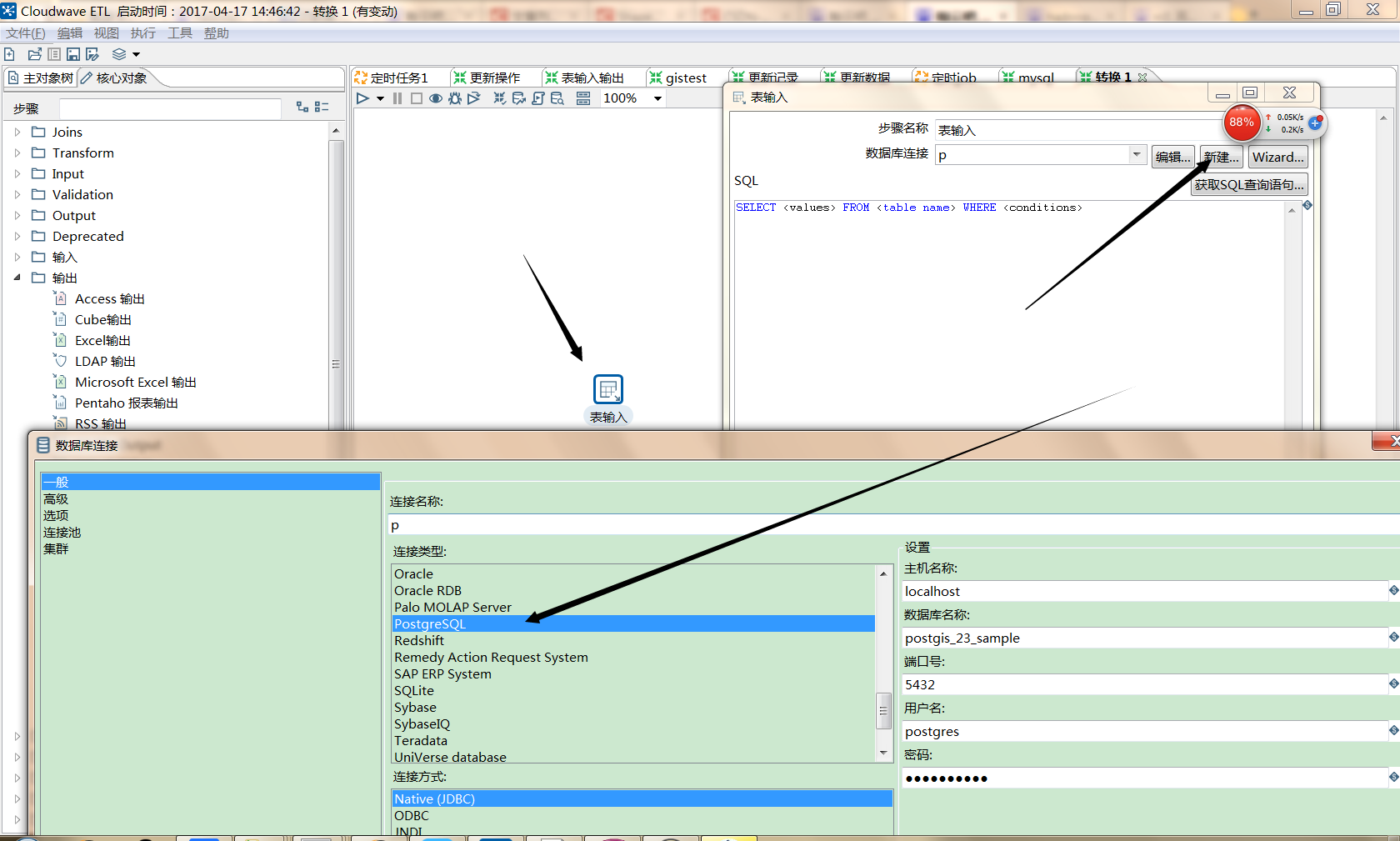Linux环境下PostgreSQL与PostGIS的安装与配置
Linux环境下PostgreSQL与PostGIS的安装、配置与简单应用
一、软件环境
1. Red Hat Linux 9
2. PostgreSQL-8.2.5
3. PostGIS-1.3.2
4. Proj-4.5.0 (to provide coordinate reprojection support within PostGIS)
5. GEOS-3.0.0Orc4 (to provide geometry tests and operations within PostGIS)
二、安装与配置
(一)PostgreSQL的安装
1. 下载源码并解压
# tar zxf postgresql-8.2.5.tar.gz
2. 进入PostgreSQL-8.2.5目录
2.1. 将安装目录设置为/opt/pgsql
# ./configure –prefix=/opt/pgsql
2.2. 编译、安装
# make
# make install
3. 增加PostgreSQL的最高访问用户并设定密码
# adduser pgadmin
# passwd pgadmin
4. 创建PostgreSQL的数据库目录,并修改目录的用户属性
# mkdir /opt/pgsql/data
# chown -R pgadmin /opt/pgsql
5. 修改PostgreSQL最高访问用户pgadmin的bash_profile
# vi /home/pgadmin/.bash_profile
添加:
PGLIB=/opt/pgsql/lib
PGDATA=/opt/pgsql/data
PATH=$PATH:/opt/pgsql/bin
MANPATH=$MANPATH:/opt/pgsql/man
export PGLIB PGDATA PATH MANPATH
6. 以用户pgadmin登录
# su – pgadmin
7. 初始化数据库存储区(initialize a database storage area)
$ /opt/pgsql/bin/initdb -D /opt/pgsql/data
一个数据库存储区也叫一个数据库群集(a database cluster,是一个正在运行的数据库服务器实例所管理的数据库的集合)
8. 启动数据库服务器(Starting the Database Server)
$ postmaster >pgsql.log 2>&1 &
(注: “>pgsql.log” 的意思是将postmaster的输出重定向到pgsql.log文件中去, “2>&1″的意思是如果有错误,错误信息也重定向输出到pgsql.log中去,最后一个 “&” 的意思是在后台运行postmaster服务程序)
或者
$ postmaster -D /opt/pgsql/data >pgsql.log 2>&1 &
或者
$ postgres -D /opt/pgsql/data >pgsql.log 2>&1 &
或者
$ pg_ctl start -D /opt/pgsql/data –l pgsql.log
9. 创建数据库
$ /opt/pgsql/bin/createdb testdb
若PostgreSQL 会返回 “CREATED DATABASE” 的信息,表明数据库建立完成
$ /opt/pgsql/bin/psql testdb //用交互工具 psql 连接进入数据库
testdb=# \i /home/postgresql/test_table.sql //执行外部SQL脚本文件
testdb=# \l //列出所有数据库
testdb=# \dt //列出被连接数据库中的表
10. 设置远程可访问数据库
$ vi /opt/pgsql/data/postgresql.conf
将listen_address = ‘localhost’ 改为 listen_address = ‘*’
$ vi /opt/pgsql/data/pg_hba.conf
在文件最后加入:
host all all 192.168.1.0/24 password
重新启动数据库
$ /opt/pg/bin/pg_ctl stop -D /opt/pgsql/data
$ /opt/pg/bin/postmaster -i -D /opt/pgsql/data>logfile 2>&1 &
这样就可以远程访问数据库了,如下边的命令:
$ psql -h 192.168.1.216 -p 5432 -d testdb -U user1
将以用户user1的身份去访问主机为192.168.1.216上名为testdb的数据库。
11. 简单应用(用于测试PostgreSQL数据库是否正常工作)
11.1. 进入数据库操作界面
$ /opt/pg/bin/psql testdb
11.2. 创建用户
testdb=# create user user1 password ‘123456’;
11.3. 创建数据库
testdb=# create database db1 owner user1;
11.4 创建表
testdb=# create table tab1(name varchar(10));
11.5 改变表的属主
testdb=# alter table tab1 owner to user1;
(二)PostGIS的安装
1. 先安装Proj4和GEOS
1.1. 安装Proj-4.5.0
# tar zxf proj-4.5.0.tar.gz
# cd proj-4.5.0
# ./configure –prefix=/opt/proj4 //设置安装位置为/opt/proj4
# make
# make install
1.2. 安装Geos-3.0.0Orc4
# tar jxf geos-3.0.0rc4.tar.bz2
# cd geos-3.0.0rc4
# ./configure –prefix=/opt/geos3 //设置安装位置为/opt/geos3
# make
# make install
2. 安装PostGIS-1.3.2
# tar zxf postgis-1.3.2.tar.gz
# cd postgis-1.3.2
# ./configure –prefix=/opt/postgis–with-pgsql=/opt/pgsql/bin/pg_config –with-proj=/opt/proj4–with-geos=/opt/geos3/bin/geos-config
(设置安装位置为/opt/postgis,并且使用Proj4与GEOS3)
# make
# make install
3. PostGIS的配置
3.1. 更改用户到pgadmin,创建测试数据库
$ createdb testgisdb //创建测试数据库
$ createlang plpgsql testgisdb //使数据库识别PL/pgSQL语言
3.2. 增加动态链接库的搜索路径
# vi /etc/ld.so.conf
在文件末尾增加下面四行:
/usr/local/lib
/opt/proj4/lib
/opt/geos3/lib
/opt/pgsql/lib
然后运行ldconfig使刚加入的库路径生效:
# /sbin/ldconfig
3.3. 进入目录/opt/postgis/share,为数据库增加空间支持:
$ psql -d trydb -f lwpostgis.sql //装入预定义的PostGIS空间类型与函数
$ psql -d testgisdb -f spatial_ref_sys.sql //装入预定义的空间坐标参照系
4. 简单使用PostGIS
$ psql testgisdb
testgisdb=# create user user2 password ‘123456’;
testgisdb=# alter database testgisdb owner to user2;
testgisdb=# alter table spatial_ref_sys owner to user2;
testgisdb=# alter table geometry_columns owner to user2;
5. 导入shp文件:
5.1. 将 test1.shp test1.shx test1.dbf 复制到/opt/postgis/bin目录下
# chmod +x test1.shp
# chmod +x test1.shx
# chmod +x test1.dbf
# chown -R pgadmin /opt/postgis/bin
5.2. 更改用户到 pgadmin
$ /opt/postgis/bin/shp2pgsql test1 test1>test1.sql
$ psql -d testgisdb -f test1.sql
$ psql testgisdb
testgisdb=# alter table test1 owner to user2;
6. 客户端登陆使用
这里用的是QuantumGIS,即QGIS
运行软件,依次打开“图层”->“添加postgis图层”->“新建”
输入名称、主机的IP地址或服务器名、数据库名、端口号(5432)、用户名及密码
点“测试连接”,看能能否正常通讯。
最后连接,选择表,然后点“添加”,添加图层
7. 设置开机自动启动PostgreSQL
7.1. 进入…/postgresql-8.2.5/contrib/start-scripts 目录,将linux文件改名复制到init.d目录下:
# cp linux /etc/rc.d/init.d/postgres
7.2. 进入/etc/rc.d/init.d目录,编辑postgres:
=============================
prefix = /opt/pgsql
PGDATA = “/opt/pgsql/data”
PGUSER = pgadmin
PGLOG = “$PGDATA/pgsql.log”
=============================
# chmod +x postgres
7.3. 分别在/etc/rc.d/rc3.d目录和/etc/rc.d/rc3.d目录,输入命令:
# ln -sf /etc/rc.d/init.d/postgres S11postgres
重启Linux,即可。
===完毕====
一、软件环境
1. Red Hat Linux 9
2. PostgreSQL-8.2.5
3. PostGIS-1.3.2
4. Proj-4.5.0 (to provide coordinate reprojection support within PostGIS)
5. GEOS-3.0.0Orc4 (to provide geometry tests and operations within PostGIS)
二、安装与配置
(一)PostgreSQL的安装
1. 下载源码并解压
# tar zxf postgresql-8.2.5.tar.gz
2. 进入PostgreSQL-8.2.5目录
2.1. 将安装目录设置为/opt/pgsql
# ./configure –prefix=/opt/pgsql
2.2. 编译、安装
# make
# make install
3. 增加PostgreSQL的最高访问用户并设定密码
# adduser pgadmin
# passwd pgadmin
4. 创建PostgreSQL的数据库目录,并修改目录的用户属性
# mkdir /opt/pgsql/data
# chown -R pgadmin /opt/pgsql
5. 修改PostgreSQL最高访问用户pgadmin的bash_profile
# vi /home/pgadmin/.bash_profile
添加:
PGLIB=/opt/pgsql/lib
PGDATA=/opt/pgsql/data
PATH=$PATH:/opt/pgsql/bin
MANPATH=$MANPATH:/opt/pgsql/man
export PGLIB PGDATA PATH MANPATH
6. 以用户pgadmin登录
# su – pgadmin
7. 初始化数据库存储区(initialize a database storage area)
$ /opt/pgsql/bin/initdb -D /opt/pgsql/data
一个数据库存储区也叫一个数据库群集(a database cluster,是一个正在运行的数据库服务器实例所管理的数据库的集合)
8. 启动数据库服务器(Starting the Database Server)
$ postmaster >pgsql.log 2>&1 &
(注: “>pgsql.log” 的意思是将postmaster的输出重定向到pgsql.log文件中去, “2>&1″的意思是如果有错误,错误信息也重定向输出到pgsql.log中去,最后一个 “&” 的意思是在后台运行postmaster服务程序)
或者
$ postmaster -D /opt/pgsql/data >pgsql.log 2>&1 &
或者
$ postgres -D /opt/pgsql/data >pgsql.log 2>&1 &
或者
$ pg_ctl start -D /opt/pgsql/data –l pgsql.log
9. 创建数据库
$ /opt/pgsql/bin/createdb testdb
若PostgreSQL 会返回 “CREATED DATABASE” 的信息,表明数据库建立完成
$ /opt/pgsql/bin/psql testdb //用交互工具 psql 连接进入数据库
testdb=# \i /home/postgresql/test_table.sql //执行外部SQL脚本文件
testdb=# \l //列出所有数据库
testdb=# \dt //列出被连接数据库中的表
10. 设置远程可访问数据库
$ vi /opt/pgsql/data/postgresql.conf
将listen_address = ‘localhost’ 改为 listen_address = ‘*’
$ vi /opt/pgsql/data/pg_hba.conf
在文件最后加入:
host all all 192.168.1.0/24 password
重新启动数据库
$ /opt/pg/bin/pg_ctl stop -D /opt/pgsql/data
$ /opt/pg/bin/postmaster -i -D /opt/pgsql/data>logfile 2>&1 &
这样就可以远程访问数据库了,如下边的命令:
$ psql -h 192.168.1.216 -p 5432 -d testdb -U user1
将以用户user1的身份去访问主机为192.168.1.216上名为testdb的数据库。
11. 简单应用(用于测试PostgreSQL数据库是否正常工作)
11.1. 进入数据库操作界面
$ /opt/pg/bin/psql testdb
11.2. 创建用户
testdb=# create user user1 password ‘123456’;
11.3. 创建数据库
testdb=# create database db1 owner user1;
11.4 创建表
testdb=# create table tab1(name varchar(10));
11.5 改变表的属主
testdb=# alter table tab1 owner to user1;
(二)PostGIS的安装
1. 先安装Proj4和GEOS
1.1. 安装Proj-4.5.0
# tar zxf proj-4.5.0.tar.gz
# cd proj-4.5.0
# ./configure –prefix=/opt/proj4 //设置安装位置为/opt/proj4
# make
# make install
1.2. 安装Geos-3.0.0Orc4
# tar jxf geos-3.0.0rc4.tar.bz2
# cd geos-3.0.0rc4
# ./configure –prefix=/opt/geos3 //设置安装位置为/opt/geos3
# make
# make install
2. 安装PostGIS-1.3.2
# tar zxf postgis-1.3.2.tar.gz
# cd postgis-1.3.2
# ./configure –prefix=/opt/postgis–with-pgsql=/opt/pgsql/bin/pg_config –with-proj=/opt/proj4–with-geos=/opt/geos3/bin/geos-config
(设置安装位置为/opt/postgis,并且使用Proj4与GEOS3)
# make
# make install
3. PostGIS的配置
3.1. 更改用户到pgadmin,创建测试数据库
$ createdb testgisdb //创建测试数据库
$ createlang plpgsql testgisdb //使数据库识别PL/pgSQL语言
3.2. 增加动态链接库的搜索路径
# vi /etc/ld.so.conf
在文件末尾增加下面四行:
/usr/local/lib
/opt/proj4/lib
/opt/geos3/lib
/opt/pgsql/lib
然后运行ldconfig使刚加入的库路径生效:
# /sbin/ldconfig
3.3. 进入目录/opt/postgis/share,为数据库增加空间支持:
$ psql -d trydb -f lwpostgis.sql //装入预定义的PostGIS空间类型与函数
$ psql -d testgisdb -f spatial_ref_sys.sql //装入预定义的空间坐标参照系
4. 简单使用PostGIS
$ psql testgisdb
testgisdb=# create user user2 password ‘123456’;
testgisdb=# alter database testgisdb owner to user2;
testgisdb=# alter table spatial_ref_sys owner to user2;
testgisdb=# alter table geometry_columns owner to user2;
5. 导入shp文件:
5.1. 将 test1.shp test1.shx test1.dbf 复制到/opt/postgis/bin目录下
# chmod +x test1.shp
# chmod +x test1.shx
# chmod +x test1.dbf
# chown -R pgadmin /opt/postgis/bin
5.2. 更改用户到 pgadmin
$ /opt/postgis/bin/shp2pgsql test1 test1>test1.sql
$ psql -d testgisdb -f test1.sql
$ psql testgisdb
testgisdb=# alter table test1 owner to user2;
6. 客户端登陆使用
这里用的是QuantumGIS,即QGIS
运行软件,依次打开“图层”->“添加postgis图层”->“新建”
输入名称、主机的IP地址或服务器名、数据库名、端口号(5432)、用户名及密码
点“测试连接”,看能能否正常通讯。
最后连接,选择表,然后点“添加”,添加图层
7. 设置开机自动启动PostgreSQL
7.1. 进入…/postgresql-8.2.5/contrib/start-scripts 目录,将linux文件改名复制到init.d目录下:
# cp linux /etc/rc.d/init.d/postgres
7.2. 进入/etc/rc.d/init.d目录,编辑postgres:
=============================
prefix = /opt/pgsql
PGDATA = “/opt/pgsql/data”
PGUSER = pgadmin
PGLOG = “$PGDATA/pgsql.log”
=============================
# chmod +x postgres
7.3. 分别在/etc/rc.d/rc3.d目录和/etc/rc.d/rc3.d目录,输入命令:
# ln -sf /etc/rc.d/init.d/postgres S11postgres
重启Linux,即可。
===完毕====
转载自:https://blog.csdn.net/huangrunqing/article/details/8781770




